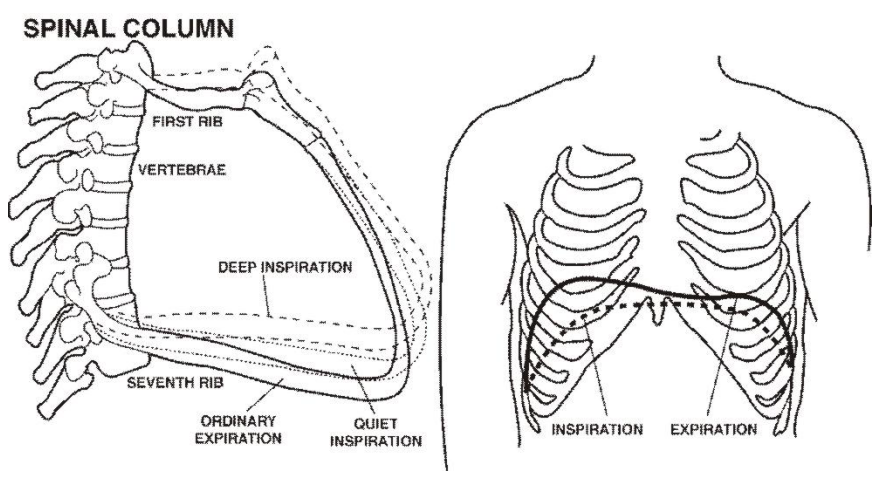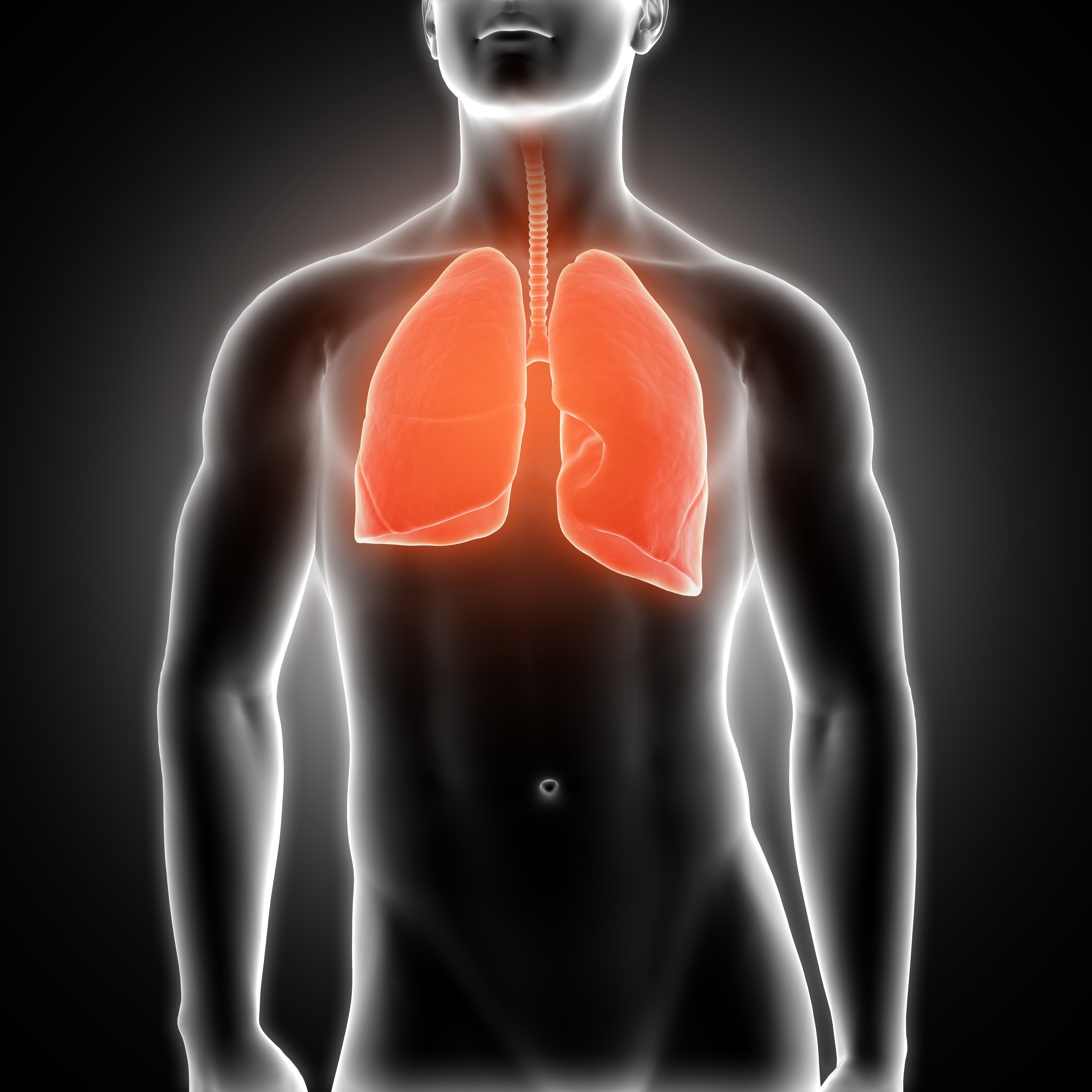The Respiratory System
The Respiratory Apparatus: The mechanism of breathing is shown in diagrammatic form in below. To breathe in, the ribs are lifted up by the muscles between them and the diaphragm is pulled down. This increases the volume in the chest cavity and air flows in. During exhalation, the muscles relax, the elasticity of the chest cavity causes it to contract, and air is blown out. The process of inspiration involves both raising the rib cage (top) and lowering the diaphragm (bottom). Both movements enlarge the volume of the thoracic cavity and draw air into the lung.

There is a potential space between the outer surface of the lung and the inside of the chest wall, which normally contains a slight vacuum. If either surface is ruptured then air will be sucked into this space when the chest expands. The resulting air pocket is known as a pneumothorax; it may occur as a result of trauma, from a diving or submarine escape accident, or for no apparent reason. Very occasionally the tear in the chest wall or lung may act as a one way valve such that air is sucked in but is not allowed out of the pleural space. This causes the pressure in the chest to increase so that eventually normal lung begins to collapse. This is known as a tension pneumothorax, which may be rapidly fatal unless treated.
Control of Breathing: As the work rate increases, oxygen demand and carbon dioxide production rise. Blood flow to the active areas is raised and, to maintain the levels of oxygen and carbon dioxide in the blood, the amount of air entering the lungs also increases. This is controlled by the respiratory center in the brain which is sensitive to the partial pressure of carbon dioxide in the blood; if this is too high the centre causes the rate and depth of breathing to increase until normal carbon dioxide levels are reached.
Control of Breathing: As the work rate increases, oxygen demand and carbon dioxide production rise. Blood flow to the active areas is raised and, to maintain the levels of oxygen and carbon dioxide in the blood, the amount of air entering the lungs also increases. This is controlled by the respiratory center in the brain which is sensitive to the partial pressure of carbon dioxide in the blood; if this is too high the centre causes the rate and depth of breathing to increase until normal carbon dioxide levels are reached.
Receptors in the carotid arteries and the aorta are sensitive to oxygen levels in the blood and send signals to the respiratory center if the level is too low. This is a less sensitive response than that for carbon dioxide and does not usually affect the rate of breathing until the oxygen level is dangerously low. Emotions such as excitement and fear may alter the respiratory rate independently of the above mechanisms
Oxygen Consumption: It is obviously important to know how much oxygen is required, and carbon dioxide produced, by a diver in order that the adequacy of their air or gas supply may be determined. Although there is considerable variability between individuals, a diver’s oxygen consumption is largely determined by their work rate

The amount of oxygen a diver consumes per minute (ie the number of oxygen molecules) is independent of depth. However the volume of gas needed to provide a given number of molecules follows Boyle’s law, so if the diver consumes 2 l/min at the surface they will only consume 1 l/min at 10 m (twice the pressure and hence half the volume). Oxygen consumption is therefore usually expressed in terms of the volume of gas at the surface measured under standard conditions (Temperature 0°C, barometric pressure 760 mmHg and with dry gas, known as STPD – Standard Temperature and Pressure Dry Gas).
Notes!
1. Diving activities are in capital letters.
2. The values shown for the amount of gas breathed each minute (RMV) are an average; there is considerable variation between individuals.
3. STPD means Standard Temperature and Pressure, Dry gas. The figures quoted relate to the medical standard of 0°C, 1 bar abs. To calculate endurance on an oxygen cylinder it is necessary to convert these values to the engineering standard (20°C, 1 bar abs). This may be done by multiplying by 1.08.
4. BTPS refers to gas volume at Body Temperature (37°C) and Pressure Saturated with water vapour. To calculate the endurance on open circuit SCUBA these figures must be converted to the engineering standard of dry gas at 20°C. This may be done by multiplying by 0.95
The rate at which breathing gas is consumed (as opposed to just oxygen) will also depend on the depth of the dive. The amount of gas, or the number of molecules of gas, breathed depends on the number of molecules of gas in each breath and the breathing rate. As depth increases, even if the breathing rate and the volume of each breath stay constant, the number of molecules of gas in each breath increases such that a breath of 500 ml at 10 m contains twice as many molecules as the same breath taken at the surface

One of the limitations of work capacity is the supply of oxygen to tissues, inefficient respiratory or cardiovascular systems, eg in those who are unfit, will limit work capacity. In an emergency, muscles may continue work for a short time without an adequate supply of oxygen. This process results in what is known as an ‘oxygen debt’; oxygen has to be consumed later to repay this debt. Another possible advantage of being in good physical condition is that a greater oxygen debt may be tolerated
Carbon Dioxide Output: The production of carbon dioxide closely follows the consumption of oxygen. As with oxygen consumption, the number of carbon dioxide molecules produced does not change with depth. The ratio of the carbon dioxide produced divided by the amount of oxygen consumed is known as the respiratory quotient.
Respiratory Quotient = CO2 Produced / O2 Consumed
This can range from 0.7 to 1.0 depending on diet and work rate. The average value of the respiratory quotient for a working diver is about 0.9.

Conclusion:
Understanding the respiratory system is vital for divers. Control of breathing, oxygen consumption, and carbon dioxide output play crucial roles in maintaining safety and optimizing work capacity underwater. Additionally, recognizing the factors that influence respiration and gas exchange can further enhance diver performance and safety.
By considering these important aspects, divers can ensure efficient gas management and maintain optimal respiratory function underwater.
